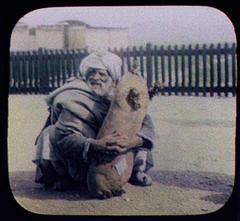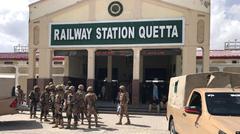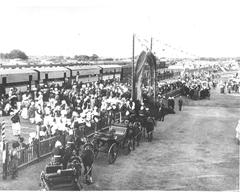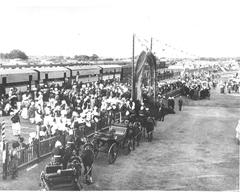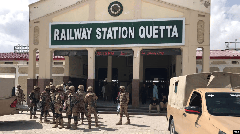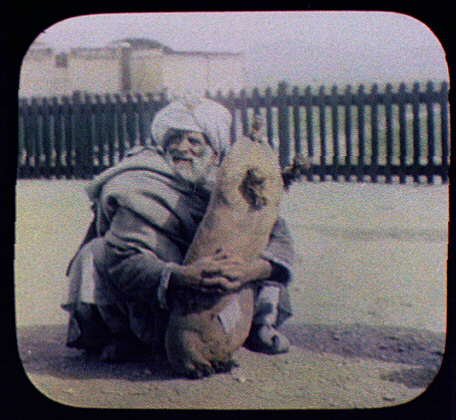
Complete Guide to Visiting Quetta Railway Station: Tickets, Visiting Hours, History & Travel Tips
Date: 14/06/2025
Introduction
Quetta Railway Station stands as both a transportation lifeline and a historical monument in the heart of Balochistan, Pakistan’s largest province. Established during the British colonial era, this station represents a remarkable blend of engineering achievement, strategic significance, and architectural evolution. Today, it continues to connect Quetta with major cities across Pakistan and serves as a gateway to Iran, all while offering modern facilities and enhanced security for travelers.
This comprehensive guide draws on authoritative sources to provide everything you need to know about Quetta Railway Station: visiting hours, ticketing options (on-site and online), historical highlights, architectural features, security considerations, travel tips, and nearby attractions. Whether you are a history buff, a first-time traveler, or a regular commuter, this resource will help you plan a seamless and enriching journey through one of Pakistan’s most iconic railway stations (pakrail.gov.pk; xploreopen.org; pakistaniat.com).
Historical Overview & Strategic Significance
Early Development & Colonial Ambitions
The origins of Quetta Railway Station are inseparable from the British Raj’s ambitions in South Asia. The mid-19th century saw strategic proposals for a railway through the Bolan Pass—an idea championed by William Andrew, aiming to secure British India’s northwest frontier and facilitate trade with Central Asia (xploreopen.org; ebrary.net). Construction began in 1881, overcoming formidable natural barriers and reaching Quetta by 1887—a testament to perseverance and technical innovation (crayon.pk; pakistaniat.com).
The Great Game & Military Strategy
The station quickly became a linchpin in the British “Great Game,” enabling rapid troop deployment and supply logistics to counter Russian advances through Afghanistan. The railway’s strategic value was pivotal during British campaigns, transforming Quetta into a powerful symbol of imperial reach (pakistaniat.com; ebrary.net).
Trans-Baluchistan Railway: Linking Nations
Expanding westward, the Trans-Baluchistan Railway (Quetta-Zahidan line) further solidified Quetta’s role as a gateway to Iran. The line opened in stages from 1905 to 1922, and by 1923, it had become the main conduit for trade and communication between British India and Persia, replacing traditional camel caravans (pakistaniat.com).
Engineering Triumphs
Overcoming the Bolan Pass and harsh desert terrain required tunnels, viaducts, and innovative solutions—such as buffet cars for long desert stretches (pakistaniat.com). These engineering feats remain visible in the station’s robust design and operational resilience.
Post-Independence & Modern Era
After 1947, Quetta Railway Station became a key hub within Pakistan’s rail network, continuing to support regional trade and mobility despite challenges posed by geography and security (ebrary.net). The Quetta-Zahidan line currently operates on a limited schedule, reflecting both the legacy and ongoing utility of this infrastructural marvel (pakistaniat.com).
Security & Heritage
Security remains a crucial concern, with recent incidents such as bombings and a train hijacking in 2025 highlighting ongoing regional instability (ctc.westpoint.edu; thenews.com.pk; theislamabadtelegraph.com). Despite these challenges, Quetta Railway Station endures as a living monument to Balochistan’s historical and strategic significance (crayon.pk).
Architectural Features
Evolution Post-1935 Earthquake
The original Indo-Saracenic architecture—marked by arches and domes—was largely lost in the devastating 1935 earthquake. Rebuilt with practicality and resilience in mind, the current station features a low-rise, reinforced concrete and brick structure, prioritizing seismic safety over ornate decoration (academia.edu).
Exterior & Interior Design
- Exterior: Utilizes local stone and brick, with wide overhanging eaves and large arched windows for ventilation.
- Interior: Spacious concourse, clear signage (Urdu and English), tiled or concrete flooring for durability, and organized passenger flow.
- Platforms: Multiple platforms accommodate long-distance services like the Jaffar Express, with overhead bridges or underpasses for safety (moveinpak.com).
Location & Accessibility
Central Location
The station is located in Quetta’s city center, accessible via major roads and public transportation (mapcarta.com). The proximity to key commercial and administrative districts enhances convenience for both residents and visitors.
Transport Connections
- National Links: Trains connect Quetta to Karachi, Lahore, Rawalpindi, Peshawar, Multan, and Chaman (umarbz.blogspot.com).
- International Link: The Quetta-Taftan line provides rail access to Iran, subject to security and visa regulations (Wikipedia).
- Local Transport: Taxis, rickshaws (including eco-friendly CNG models), and buses are readily available (Wikivoyage).
Visiting Hours & Ticketing
Station Hours
Quetta Railway Station generally operates from 5:00 AM to 11:00 PM, though hours may adjust during holidays or security alerts.
Ticketing Options
- On-Site: Multiple counters for manual and computerized ticketing.
- Online: Book via the official Pakistan Railways website (pakrail.gov.pk) or the Pakistan Railway Seat Reservation mobile app (GoTest).
- Payment: Digital wallets (JazzCash, EasyPaisa, Upaisa) are accepted; e-tickets can be saved or printed.
- Fares: Vary by route, train, and class. For example, economy from Quetta to Karachi is up to PKR 800; to Islamabad, up to PKR 1,850 (PakInformation).
Facilities & Services
- Waiting Areas: Segregated by gender and class, with comfort amenities.
- Refreshments: Stalls offering snacks, drinks, and travel essentials.
- Restrooms & Prayer Area: Clean facilities and a designated mosque are available.
- Accessibility: Ramps and handrails for differently-abled passengers; staff assistance upon request.
- Security: Surveillance cameras, uniformed personnel, baggage screening, and strict entry protocols.
- Parking: On-site parking for cars, motorcycles, and bicycles.
- Luggage Services: Porters available for a nominal fee.
- Information Desk & Lost & Found: Staffed counters for assistance and recovery of lost items.
- Digital Services: Real-time schedule updates via the official website and app.
Train Services
Quetta Railway Station serves as a critical node for nine prominent trains, including:
- Jaffar Express: Daily service to Peshawar, traversing all four provinces (Wikipedia).
- Chaman Passenger Express: Connects Quetta with Chaman on the Afghan border.
- Quetta Express: Direct service to Lahore.
- Akbar Express & Bolan Mail: Frequent services to Karachi.
- Other Links: Trains to Rawalpindi, Multan, and Sibi.
International service to Iran (Zahidan) operates on a limited, security-dependent schedule.
Security & Travel Considerations
Recent years have seen targeted attacks at or near the station, prompting heightened security, periodic service suspensions, and increased surveillance (thenews.com.pk; tribune.com.pk). Foreign travelers require police permission and escorts while in Quetta (Wikivoyage). Always check for travel advisories before planning your trip.
Nearby Attractions
Enhance your visit by exploring:
- Hanna Lake: A scenic spot ideal for nature lovers.
- Quetta Fort: Offers panoramic city views.
- Hazarganji Chiltan National Park: Perfect for wildlife and trekking.
- Ayub National Stadium & Local Bazaars: Experience Quetta’s vibrant culture.
Practical Travel Tips
- Book tickets in advance, especially during peak seasons.
- Arrive 30–45 minutes early for security checks.
- Carry valid ID and, if foreign, all required permits.
- Use official sources for train schedules and advisories.
- Stay vigilant and secure your belongings at all times.
Frequently Asked Questions (FAQs)
Q: What are the opening hours of Quetta Railway Station?
A: Generally 5:00 AM to 11:00 PM, aligned with train schedules.
Q: How can I buy tickets?
A: On-site at counters or online via pakrail.gov.pk or the Pakistan Railway Seat Reservation app.
Q: Are there facilities for differently-abled passengers?
A: Yes, with ramps, handrails, and staff assistance available.
Q: Is the station safe?
A: Enhanced security measures are in place, but travelers should remain alert and check advisories.
Q: Can foreigners use the station?
A: Yes, but they require police permission and sometimes escorts.
Q: What are the main trains serving Quetta?
A: Jaffar Express, Chaman Passenger Express, Quetta Express, Akbar Express, and Bolan Mail, among others.
Conclusion & Recommendations
Quetta Railway Station is more than a transport hub—it is a living monument to Balochistan’s layered history, strategic value, and enduring resilience. Its architectural evolution, extensive connectivity, and robust facilities make it a vital stop for travelers exploring Pakistan or venturing toward Iran. By utilizing online booking tools, staying informed about security, and exploring nearby attractions, visitors can make the most of their journey.
Plan ahead, stay informed, and discover the heritage and connectivity of Quetta Railway Station!
Useful Sources & Official Links
- Quetta Railway Station: Visiting Hours, Tickets, History & Travel Guide, 2025
- Pakistan’s Railway Painful History, 2025
- The Trans-Baluchistan Railway, 2007
- Historical Places of Balochistan, 2025
- The Baloch Insurgency in Pakistan: Evolution, Tactics, and Regional Security Implications, 2025
- Quetta Railway Station Blast Kills 4, Injures 20, 2024
- Suicide Attack in Pakistan, 2024
- Transformation in Architectural styles of Quetta since 1935 Earthquake, 2024
- Jaffar Express Train Ticket Price and Time Schedule, 2025
- Five Largest and Busiest Railway Stations in Pakistan, 2024
- Quetta Railway Station, Wikipedia, 2025
- Train Services in Quetta Suspended Amid Security Situation, 2024
- Pakistan Railways History, Significance & More, 2025
- Traveling in Balochistan, Wikivoyage, 2025
For real-time updates, ticket bookings, and live travel alerts, download the Audiala app and follow our official social media channels.
